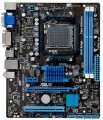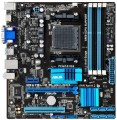Size (HxW)
Motherboard dimensions in height and width. It is assumed that the traditional placement of motherboards is vertical, so in this case one of the dimensions is called not the length, but the height.
Motherboard sizes are largely determined by their form factors (see above), however, the size of a particular motherboard may differ slightly from the standard adopted for this form factor. In addition, it is usually easier to clarify the dimensions according to the characteristics of a particular motherboard than to look for or remember general information on the form factor. Therefore, size data can be given even for models that fully comply with the standard.
The third dimension — thickness — is considered less important for a number of reasons, so it is often omitted.
DDR3
The number of slots for DDR3 memory sticks provided in the motherboard.
DDR3 is the third generation of RAM with the so-called double data transfer. Some time ago, this standard was the most popular in computer technology, but now it is increasingly losing ground to the newer and more advanced DDR4. However, DDR3 boards are still on the market; they can have
2,
4, or even
6 or more slots for such memory.
Max. clock frequency
The maximum RAM clock speed supported by the motherboard. The actual clock frequency of the installed RAM modules should not exceed this indicator — otherwise, malfunctions are possible, and the capabilities of the “RAM” cannot be used to the fullest.
For modern PCs, a RAM frequency of
1500 – 2000 MHz or
less is considered very low,
2000 – 2500 MHz is modest,
2500 – 3000 MHz is average,
3000 – 3500 MHz is above average, and the most advanced boards can support frequencies of
3500 – 4000 MHz and even
more than 4000 MHz.
Max. memory
The maximum amount of RAM that can be installed on the motherboard.
When choosing according to this parameter, it is important to take into account the planned use of the PC and the real needs of the user. So, volumes
up to 32 GB inclusive are quite enough to solve any basic problems and run games comfortably, but without a significant reserve for an upgrade.
64 GB is the optimal option for many professional use cases, and for the most resource-intensive tasks like 3D rendering,
96 GB or even
128 GB of memory will not be a limit. The most “capacious” motherboards are compatible with volumes of
192 GB or
more - they are mainly top-end solutions for servers and HEDT (see “In the direction”).
You can choose this parameter with a reserve – taking into account a potential RAM upgrade, because installing additional RAM sticks is the simplest way to increase system performance. Taking this factor into account, many relatively simple motherboards support very significant amounts of RAM.
Integrated graphics
The motherboard has its own graphics card — a module for processing and outputting a video signal.
This module can be built
into the board itself or into the
processor originally installed on it (see "Embedded processor"). Anyway, this feature saves the user from having to purchase a separate graphics card. On the other hand, to work with video, the integrated video chip uses a part of the total amount of RAM, and therefore the performance of such video cards is usually not very high. Thus, the optimal choice is often a "motherboard"
without an integrated graphics card.
, involving the installation of a separate graphics adapter (this category includes, in particular, almost all boards for professional and gaming purposes).
Integrated graphics model
The name of the integrated graphics card (see above) installed in the motherboard. Knowing the name of the graphics module, you can, if necessary, easily find detailed information about it — full specifications, tests, reviews, etc.
Hybrid mode
Hybrid mode support is only found on motherboards equipped with native graphics cards (see Integrated graphics card). When an additional separate graphics card is installed on such a board, the system can automatically optimize the operation of video adapters depending on the current tasks: use a relatively low-power, but economical and silent motherboard's own video chip for simple actions (working with documents, web surfing) and additionally connect a powerful external graphics card to work with resource-intensive applications (games, HD video, 3D rendering). Purchasing a motherboard that supports hybrid mode makes sense only if you plan to install a separate graphics card on it. In this case, it is worthwhile to separately clarify the compatibility of this graphics card and the motherboard.
HDMI output
The motherboard has its own
HDMI output.
Such an output is intended for transmitting video from an integrated graphics card (see above) or a processor with integrated graphics (we emphasize that it is impossible to output a signal from a discrete graphics card through the motherboard chipset). As for HDMI specifically, it is a combined digital video/audio interface specifically designed to work with HD resolutions and multi-channel audio. Today it is the most common of these interfaces, HDMI support is almost mandatory for video devices that are compatible with HD standards.
The specific capabilities of HDMI vary by version (see below for more details), but in general they are quite impressive — even in the earliest (current today) HDMI v.1.4, the maximum resolution is 4K, and in newer standards it reaches 10K. So in motherboards, the quality of the video transmitted through such an output is often limited not by the interface capabilities, but by the graphics performance of the system.
LAN controller
Model of the LAN controller installed in the motherboard.
The LAN controller provides data exchange between the card and the network port(s) of the computer. Accordingly, both general characteristics and individual features of the network functionality of the "motherboard" depend on the characteristics of this module: support for special technologies, connection quality in case of unstable communication, etc. Knowing the model of the LAN controller, you can find detailed data on it — including including practical reviews; this information is rarely needed by the average user, but it can be useful for online game enthusiasts and for some specific tasks.
Thus, the LAN controller model is specified mainly in cases where it is a rather advanced solution that is noticeably superior to standard models. Such solutions are currently produced mainly under the brands
Intel(middle level),
Realtek(relatively simple models),
Aquntia and
Killer(mostly advanced solutions).

